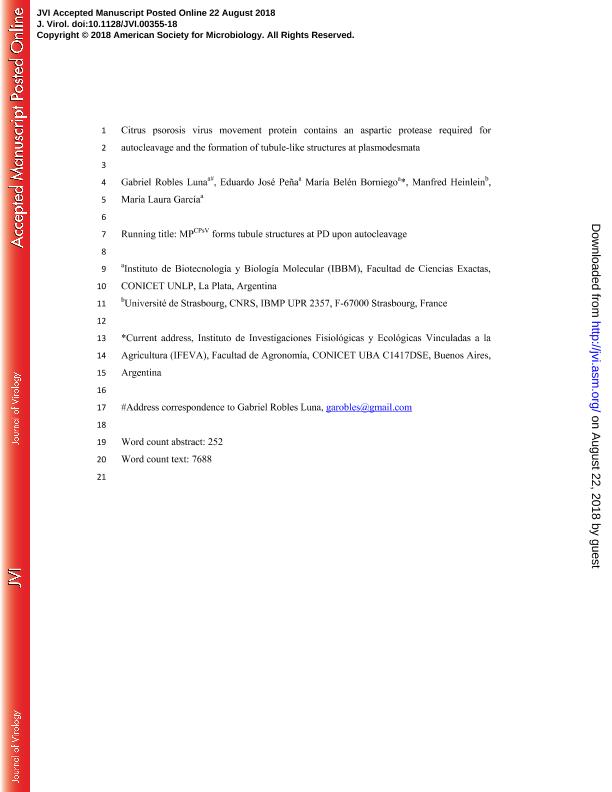Mostrar el registro sencillo del ítem
dc.contributor.author
Robles Luna, Gabriel

dc.contributor.author
Peña, Eduardo José

dc.contributor.author
Borniego, María Belén

dc.contributor.author
Heinlein, Manfred
dc.contributor.author
Garcia, Maria Laura

dc.date.available
2020-03-18T14:23:58Z
dc.date.issued
2018-11
dc.identifier.citation
Robles Luna, Gabriel; Peña, Eduardo José; Borniego, María Belén; Heinlein, Manfred; Garcia, Maria Laura; Citrus psorosis virus movement protein contains an aspartic protease required for autocleavage and the formation of tubule-like structures at plasmodesmata; American Society for Microbiology; Journal of Virology; 92; 21; 11-2018; 1-38
dc.identifier.issn
0022-538X
dc.identifier.uri
http://hdl.handle.net/11336/99989
dc.description.abstract
Plant virus cell-to-cell movement is an essential step in viral infections. This process is facilitated by specific virus-encoded movement proteins (MPs), which manipulate the cell wall channels between neighboring cells known as plasmodesmata (PD). Citrus psorosis virus (CPsV) infection in sweet orange involves the formation of tubule-like structures within PD, suggesting that CPsV belongs to "tubuleforming" viruses that encode MPs able to assemble a hollow tubule extending between cells to allow virus movement. Consistent with this hypothesis, we show that the MP of CPsV (MPCPsV) indeed forms tubule-like structures at PD upon transient expression in Nicotiana benthamiana leaves. Tubule formation by MPCPsV depends on its cleavage capacity, mediated by a specific aspartic protease motif present in its primary sequence. A single amino acid mutation in this motif abolishes MPCPsV cleavage, alters the subcellular localization of the protein, and negatively affects its activity in facilitating virus movement. The amino-terminal 34-kDa cleavage product (34KCPsV), but not the 20-kDa fragment (20KCPsV), supports virus movement. Moreover, similar to tubule-forming MPs of other viruses, MPCPsV (and also the 34KCPsV cleavage product) can homooligomerize, interact with PD-located protein 1 (PDLP1), and assemble tubule-like structures at PD by a mechanism dependent on the secretory pathway. 20KCPsV retains the protease activity and is able to cleave a cleavage-deficient MPCPsV in trans. Altogether, these results demonstrate that CPsV movement depends on the autolytic cleavage of MPCPsV by an aspartic protease activity, which removes the 20KCPsV protease and thereby releases the 34KCPsV protein for PDLP1-dependent tubule formation at PD. IMPORTANCE Infection by citrus psorosis virus (CPsV) involves a self-cleaving aspartic protease activity within the viral movement protein (MP), which results in the production of two peptides, termed 34KCPsV and 20KCPsV, that carry the MP and viral protease activities, respectively. The underlying protease motif within the MP is also found in the MPs of other members of the Aspiviridae family, suggesting that protease-mediated protein processing represents a conserved mechanism of protein expression in this virus family. The results also demonstrate that CPsV and potentially other ophioviruses move by a tubule-guided mechanism. Although several viruses from different genera were shown to use this mechanism for cell-to-cell movement, our results also demonstrate that this mechanism is controlled by posttranslational protein cleavage. Moreover, given that tubule formation and virus movement could be inhibited by a mutation in the protease motif, targeting the protease activity for inactivation could represent an important approach for ophiovirus control.
dc.format
application/pdf
dc.language.iso
eng
dc.publisher
American Society for Microbiology

dc.rights
info:eu-repo/semantics/openAccess
dc.rights.uri
https://creativecommons.org/licenses/by-nc-sa/2.5/ar/
dc.subject
ASPARTIC PROTEASE
dc.subject
CITRUS PSOROSIS VIRUS
dc.subject
MOVEMENT PROTEIN
dc.subject
OPHIOVIRIDAE
dc.subject
PLASMODESMA-LOCATED PROTEINS
dc.subject
PLASMODESMATA
dc.subject
VIRUS MOVEMENT
dc.subject.classification
Virología

dc.subject.classification
Ciencias Biológicas

dc.subject.classification
CIENCIAS NATURALES Y EXACTAS

dc.title
Citrus psorosis virus movement protein contains an aspartic protease required for autocleavage and the formation of tubule-like structures at plasmodesmata
dc.type
info:eu-repo/semantics/article
dc.type
info:ar-repo/semantics/artículo
dc.type
info:eu-repo/semantics/publishedVersion
dc.date.updated
2019-10-04T13:40:32Z
dc.journal.volume
92
dc.journal.number
21
dc.journal.pagination
1-38
dc.journal.pais
Estados Unidos

dc.journal.ciudad
Madison
dc.description.fil
Fil: Robles Luna, Gabriel. Consejo Nacional de Investigaciones Científicas y Técnicas. Centro Científico Tecnológico Conicet - La Plata. Instituto de Biotecnología y Biología Molecular. Universidad Nacional de La Plata. Facultad de Ciencias Exactas. Instituto de Biotecnología y Biología Molecular; Argentina
dc.description.fil
Fil: Peña, Eduardo José. Consejo Nacional de Investigaciones Científicas y Técnicas. Centro Científico Tecnológico Conicet - La Plata. Instituto de Biotecnología y Biología Molecular. Universidad Nacional de La Plata. Facultad de Ciencias Exactas. Instituto de Biotecnología y Biología Molecular; Argentina
dc.description.fil
Fil: Borniego, María Belén. Consejo Nacional de Investigaciones Científicas y Técnicas. Centro Científico Tecnológico Conicet - La Plata. Instituto de Biotecnología y Biología Molecular. Universidad Nacional de La Plata. Facultad de Ciencias Exactas. Instituto de Biotecnología y Biología Molecular; Argentina
dc.description.fil
Fil: Heinlein, Manfred. Université de Strasbourg; Francia. Centre National de la Recherche Scientifique; Francia
dc.description.fil
Fil: Garcia, Maria Laura. Consejo Nacional de Investigaciones Científicas y Técnicas. Centro Científico Tecnológico Conicet - La Plata. Instituto de Biotecnología y Biología Molecular. Universidad Nacional de La Plata. Facultad de Ciencias Exactas. Instituto de Biotecnología y Biología Molecular; Argentina
dc.journal.title
Journal of Virology

dc.relation.alternativeid
info:eu-repo/semantics/altIdentifier/url/https://jvi.asm.org/content/92/21/e00355-18
dc.relation.alternativeid
info:eu-repo/semantics/altIdentifier/doi/http://dx.doi.org/10.1128/JVI.00355-18
Archivos asociados
